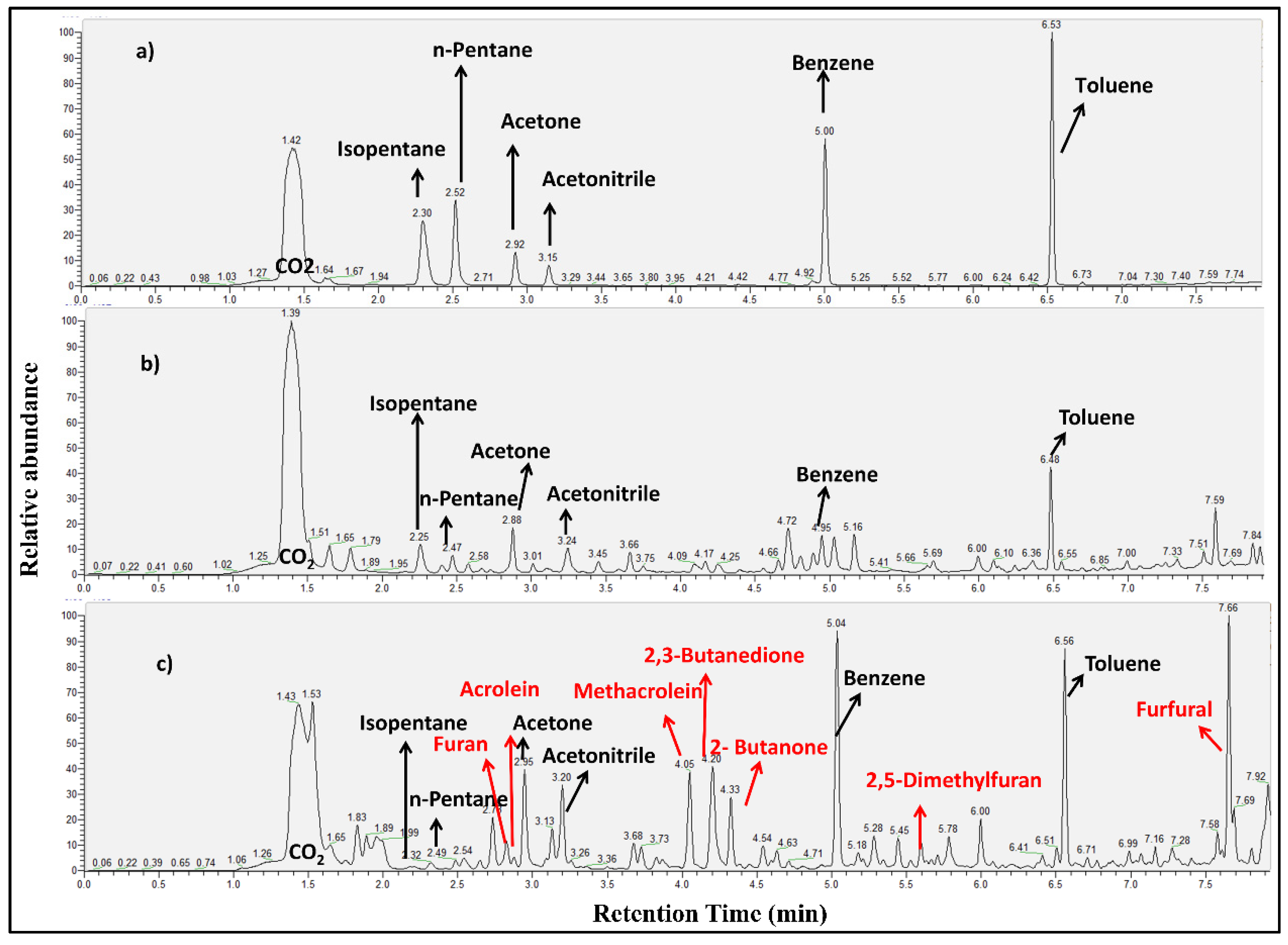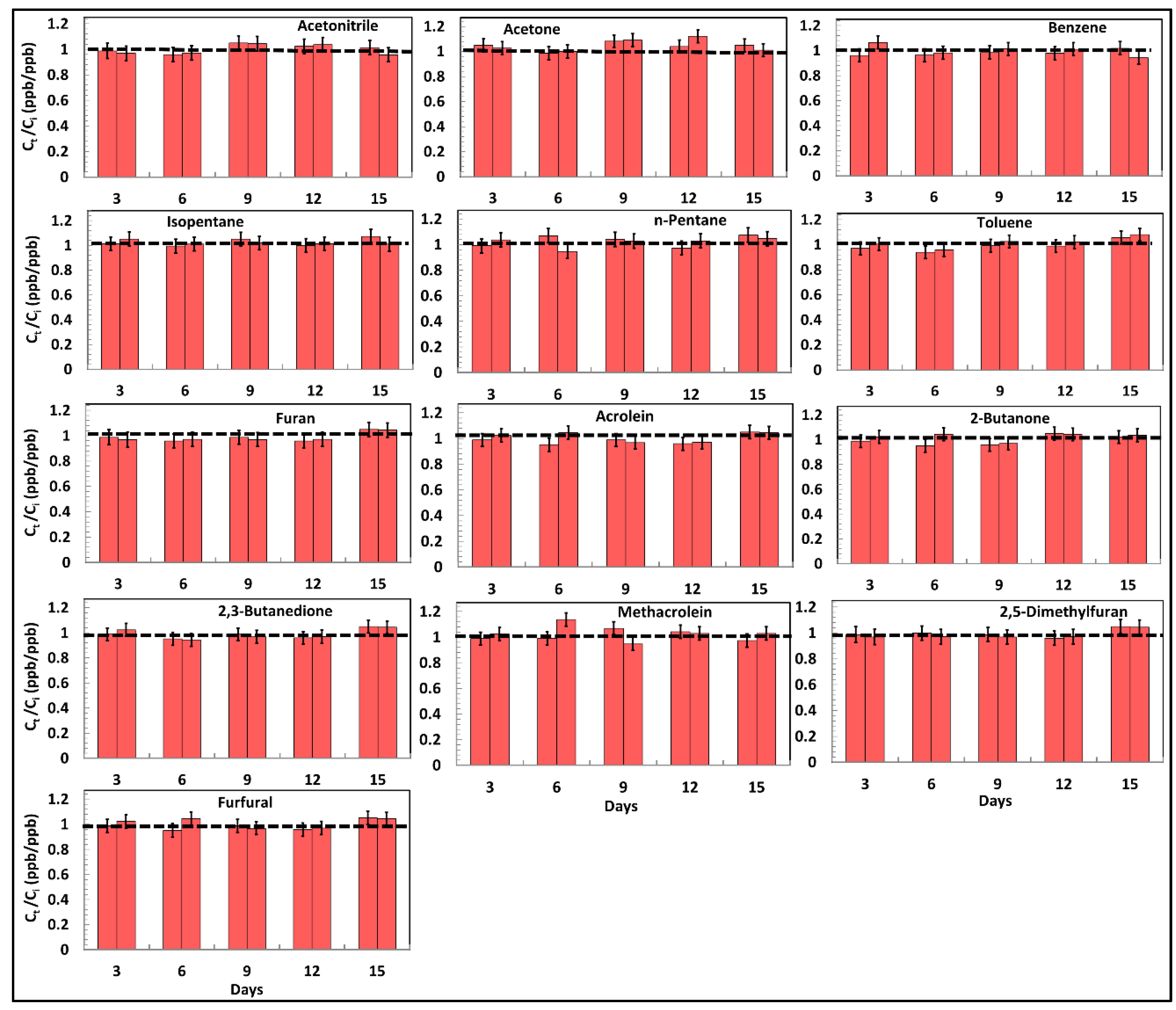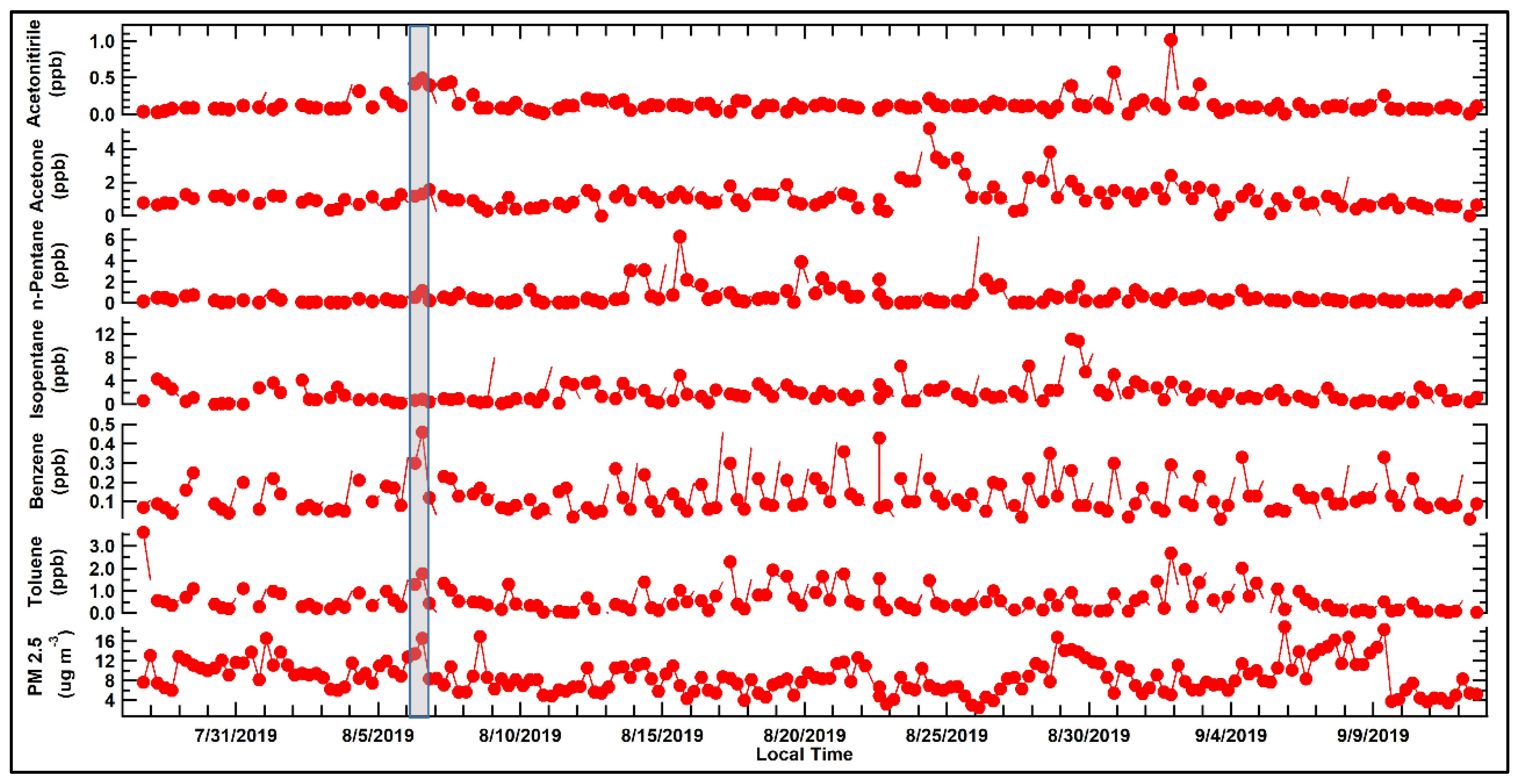Optimization of a Method for the Detection of Biomass-Burning Relevant VOCs in Urban Areas Using Thermal Desorption Gas Chromatography Mass Spectrometry
Abstract
1. Introduction
2. Experimental Methods
2.1. Description of VOC Auto-sampler and Dual-be d Thermal Desorption Tube
2.2. Analysis of VOCs Sampled TD Tubes using TD-GC-MS
3. Results and Discussion
3.1. Validation Experiments Assessing Stability of VOCs inside TD Tubes over a 15-day Period
3.1.1. Experiments with Gas Mixtures Containing the Thirteen VOCs
3.1.2. Experiments with Wood Smoke Containing the Thirteen VOCs
3.2. Application of the Dual-bed TD Tubes with VOC Auto-samplers in Ambient Air at A Ground Site in Boise, Idaho
4. Conclusions
Supplementary Materials
Author Contributions
Funding
Acknowledgments
Conflicts of Interest
References
- Andreae, M.O.; Merlet, P. Emission of trace gases and aerosols from biomass burning. Glob. Biogeochem. Cycles 2001, 15, 955–966. [Google Scholar] [CrossRef]
- Akagi, S.K.; Yokelson, R.J.; Wiedinmyer, C.; Alvarado, M.J.; Reid, J.S.; Karl, T.; Crounse, J.D.; Wennberg, P.O. Emission factors for open and domestic biomass burning for use in atmospheric models. Atmos. Chem. Phys. 2011, 11, 4039–4072. [Google Scholar] [CrossRef]
- Kumar, V.; Chandra, B.P.; Sinha, V. Large unexplained suite of chemically reactive compounds present in ambient air due to biomass fires. Sci. Rep. 2018, 8, 626. [Google Scholar] [CrossRef] [PubMed]
- Jaffe, D.A.; Wigder, N.; Downey, N.; Pfister, G.; Boynard, A.; Reid, S.B. Impact of wildfires on ozone exceptional events in the western US. Environ. Sci. Technol. 2013, 47, 11065–11072. [Google Scholar] [CrossRef] [PubMed]
- Zhang, L.; Jacob, D.J.; Yue, X.; Downey, N.V.; Wood, D.A.; Blewitt, D. Sources contributing to background surface ozone in the US Intermountain West. Atmos. Chem. Phys. 2014, 14, 5295–5309. [Google Scholar] [CrossRef]
- Jaffe, D.A.; Wigder, N.L. Ozone production from wildfires: A critical review. Atmos Environ. 2012, 51, 1–10. [Google Scholar] [CrossRef]
- Buysse, C.E.; Kaulfus, A.; Nair, U.; Jaffe, D.A. Relationships between Particulate Matter, Ozone, and Nitrogen Oxides during Urban Smoke Events in the Western US. Environ. Sci. Technol. 2019, 53, 12519–12528. [Google Scholar] [CrossRef]
- Lu, X.; Zhang, L.; Yue, X.; Zhang, J.; Jaffe, D.A.; Stohl, A.; Shao, J. Wildfire influences on the variability and trend of summer surface ozone in the mountainous western United States. Atmos. Chem. Phys. 2016, 16, 14687–14702. [Google Scholar] [CrossRef]
- Baker, K.R.; Woody, M.C.; Tonnesen, G.S.; Hutzell, W.; Pye, H.O.T.; Beaver, M.R.; Pouliot, G.; Pierce, T. Contribution of regional-scale fire events to ozone and PM2.5 air quality estimated by photochemical modeling approaches. Atmos. Environ. 2016, 140, 539–554. [Google Scholar] [CrossRef]
- Holzinger, R.; Jordan, A.; Hansel, A.; Lindinger, W. Automobile emissions of acetonitrile: Assessment of its contribution to the global source. J. Atmos. Chem. 2001, 38, 187–193. [Google Scholar] [CrossRef]
- Christian, T.J.; Kleiss, B.; Yokelson, R.J.; Holzinger, R.; Crutzen, P.J.; Hao, W.M.; Saharjo, B.H.; Ward, D.E. Comprehensive laboratory measurements of biomass-burning emissions: 1. Emissions from Indonesian, African, and other fuels. J. Geophys. Res. Atmos. 2003, 108, 4719. [Google Scholar] [CrossRef]
- Gilman, J.B.; Lerner, B.M.; Kuster, W.C.; Goldan, P.D.; Warneke, C.; Veres, P.R.; Roberts, J.M.; De Gouw, J.A.; Burling, I.R.; Yokelson, R. Biomass burning emissions and potential air quality impacts of volatile organic compounds and other trace gases from temperate fuels common in the United States. Atmos. Chem. Phys. 2015, 15, 13915–13938. [Google Scholar] [CrossRef]
- De Gouw, J.A.; Warneke, C.; Stohl, A.; Wollny, A.G.; Brock, C.A.; Cooper, O.R.; Holloway, J.S.; Trainer, M.; Fehsenfeld, F.C.; Atlas, E.L.; et al. Volatile organic compounds composition of merged and aged forest fire plumes from Alaska and western Canada. J. Geophys. Res. 2006, 111. [Google Scholar] [CrossRef]
- Warneck, p.; Williams, J. Overview on important trace gases in the troposphere: Approximate residence times, molar mixing ratios, global distribution, sources and sinks. In The Atmospheric Chemist’s Companion; Springer: Berlin, Germany, 2012; pp. 70–72. [Google Scholar]
- Andreae, M.O. Emission of trace gases and aerosols from biomass burning—An updated assessment. Atmos. Chem. Phys. 2019, 19, 8523–8546. [Google Scholar] [CrossRef]
- Koss, A.R.; Sekimoto, K.; Gilman, J.B.; Selimovic, V.; Coggon, M.M.; Zarzana, K.J.; Yuan, B.; Lerner, B.M.; Brown, S.S.; Jimenez, J.L.; et al. Non-methane organic gas emissions from biomass burning: Identification, quantification, and emission factors from PTR-ToF during the FIREX 2016 laboratory experiment. Atmos. Chem. Phys. 2018, 18, 3299–3319. [Google Scholar] [CrossRef]
- Stockwell, C.E.; Veres, P.R.; Williams, J.; Yokelson, R.J. Characterization of biomass burning emissions from cooking fires, peat, crop residue, and other fuels with high-resolution proton-transfer-reaction time-of-flight mass spectrometry. Atmos. Chem. Phys. 2015, 15, 845–865. [Google Scholar] [CrossRef]
- Chandra, B.P.; Sinha, V. Contribution of post-harvest agricultural paddy residue fires in the N.W. Indo-Gangetic Plain to ambient carcinogenic benzenoids, toxic isocyanic acid and carbon monoxide. Environ. Int. 2016, 88, 187–197. [Google Scholar] [CrossRef]
- Hatch, L.E.; Luo, W.; Pankow, J.F.; Yokelson, R.J.; Stockwell, C.E.; Barsanti, K.C. Identification and quantification of gaseous organic compounds emitted from biomass burning using two-dimensional gas chromatography–time-of-flight mass spectrometry. Atmos. Chem. Phys. 2015, 15, 1865–1899. [Google Scholar] [CrossRef]
- Chandra, B.P.; Sinha, V.; Hakkim, H.; Sinha, B. Storage stability studies and field application of low cost glass flasks for analyses of thirteen ambient VOCs using proton transfer reaction mass spectrometry. Int. J. Mass Spectrom. 2017, 419, 11–19. [Google Scholar] [CrossRef]
- Ras, M.R.; Borrull, F.; Marcé, R.M. Sampling and preconcentration techniques for determination of volatile organic compounds in air samples. Trends Anal. Chem. 2009, 28, 347–361. [Google Scholar] [CrossRef]
- Aragón, P.; Atienza, J.; Climent, M.D. Analysis of Organic Compounds in Air: A Review. Crit. Rev. Anal. Chem. 2000, 30, 121–151. [Google Scholar] [CrossRef]
- Pérez Ballesta, P.; Grandesso, E.; Field, R.A.; Cabrerizo, A. Validation and modelling of a novel diffusive sampler for determining concentrations of volatile organic compounds in air. Anal. Chim. Acta 2016, 908, 102–112. [Google Scholar] [CrossRef] [PubMed]
- Kim, Y.-H.; Kim, K.-H.; Jo, S.-H.; Jeon, E.-C.; Sohn, J.R.; Parker, D.B. Comparison of storage stability of odorous VOCs in polyester aluminum and polyvinyl fluoride Tedlar® bags. Anal. Chim. Acta 2012, 712, 162–167. [Google Scholar] [CrossRef] [PubMed]
- U.S. EPA. Compendium of Methods for the Determination of Toxic Organic Compounds in Ambient Air, Compendium Method TO-17: Determination of Volatile Organic Compounds in Ambient Air Using Active Sampling onto Sorbent Tubes, 2nd ed.; EPA/625/R-96/010b; EPA: Cincinatti, OH, USA, 1999. Available online: https://www3.epa.gov/ttnamti1/files/ambient/airtox/to-17r.pdf (accessed on 3 May 2019).
- Helmig, D. Ozone removal techniques in the sampling of atmospheric volatile organic trace gases. Atmos. Environ. 1997, 31, 3635–3651. [Google Scholar] [CrossRef]
- Pollmann, J.; Ortega, J.; Helmig, D. Analysis of atmospheric sesquiterpenes: Sampling losses and mitigation of ozone interferences. Environ. Sci. Technol. 2005, 39, 9620–9629. [Google Scholar] [CrossRef] [PubMed]
- Harper, M. Sorbent trapping of volatile organic compounds from air. J. Chromatogr. A 2000, 885, 129–151. [Google Scholar] [CrossRef]
- Coggon, M.M.; Lim, C.Y.; Koss, A.R.; Sekimoto, K.; Yuan, B.; Gilman, J.B.; Hagan, D.H.; Selimovic, V.; Zarzana, K.J.; Brown, S.S.; et al. OH chemistry of non-methane organic gases (NMOGs) emitted from laboratory and ambient biomass burning smoke: Evaluating the influence of furans and oxygenated aromatics on ozone and secondary NMOG formation. Atmos. Chem. Phys. 2019, 19, 14875–14899. [Google Scholar] [CrossRef]
- Karl, T.G.; Christian, T.J.; Yokelson, R.J.; Artaxo, P.; Hao, W.M.; Guenther, A. The Tropical Forest and Fire Emissions Experiment: Method evaluation of volatile organic compound emissions measured by PTR-MS, FTIR, and GC from tropical biomass burning. Atmos. Chem. Phys. 2007, 7, 5883–5897. [Google Scholar] [CrossRef]
- Gilman, J.B.; Lerner, B.M.; Kuster, W.C.; De Gouw, J.A. Source signature of volatile organic compounds from oil and natural gas operations in northeastern Colorado. Environ. Sci. Technol. 2013, 47, 1297–1305. [Google Scholar] [CrossRef]
- Baker, A.K.; Beyersdorf, A.J.; Doezema, L.A.; Katzenstein, A.; Meinardi, S.; Simpson, I.J.; Blake, D.R.; Sherwood Rowland, F. Measurements of nonmethane hydrocarbons in 28 United States cities. Atmos Environ. 2008, 42, 170–182. [Google Scholar] [CrossRef]
- Draxler, R.; Rolph, G. HYSPLIT (HYbrid Single-Particle Lagrangian Integrated Trajectory), Model Access via NOAA ARL READY Website; NOAA Air Resources Laboratory: College Park, MD, USA, 2013. [Google Scholar]





| Compound Name | DL (ng) | DL (ppb) | Precision Error of Duplicate Pairs (%) | Precision for the Distributed Volume Pairs (%) |
|---|---|---|---|---|
| Acetonitrile | 1.08 | 0.03 | 4.35 | 12.34 |
| Acetone | 1.69 | 0.03 | 5.48 | 12.78 |
| n-Pentane | 1.06 | 0.02 | 9.15 | 15.34 |
| iso-pentane | 1.05 | 0.02 | 6.34 | 13.23 |
| Benzene | 2.08 | 0.03 | 7.96 | 11.45 |
| Toluene | 2.03 | 0.03 | 4.57 | 10.23 |
| Furan | 1.10 | 0.03 | 7.21 | 15.94 |
| Acrolein | 1.59 | 0.04 | 8.47 | 18.74 |
| 2-Butanone | 1.76 | 0.04 | 10.16 | 19.89 |
| 2,3-Butanedione | 1.92 | 0.04 | 11.37 | 18.14 |
| Methacrolein | 2.10 | 0.03 | 13.66 | 19.95 |
| 2,5-Dimethylfuran | 2.12 | 0.04 | 12.55 | 15.13 |
| Furfural | 2.05 | 0.05 | 14.50 | 20.59 |
| Compounds (ppb) | Spokane (n = 88) | Boise (n = 183) | Baltimore * | Boston * | Houston * | Pittsburgh * | Richmond * | San-Diego * |
|---|---|---|---|---|---|---|---|---|
| Acetonitrile | 0.11 (0.09) | 0.14 (0.11) | - | - | - | - | - | - |
| Acetone | 0.72(0.46) | 1.14 (0.74) | - | - | - | - | - | - |
| n-Pentane | 0.37 (0.37) | 0.64 (0.61) | 0.15 (0.04) | 0.11 (0.03) | 0.23 (0.12) | 0.31 (0.15) | 0.11 (0.07) | 0.4 (0.4) |
| Isopentane | 2.2 (2.20) | 1.89 (1.82) | 0.4 (0.1) | 0.31 (0.09) | 0.6 (0.3) | 0.4 (0.2) | 0.24 (0.18) | 1.21 (0.69) |
| Benzene | 0.09 (0.07) | 0.14 (0.09) | 0.19 (0.15) | 0.09 (0.02) | 0.16 (0.07) | 0.09 (0.03) | 0.11 (0.06) | 0.12 (0.07) |
| Toluene | 0.25 (0.25) | 0.64 (0.56) | 1.5 (0.8) | 0.2 (0.06) | 0.6 (0.34) | 0.26 (0.14) | 0.19 (0.16) | 0.2 (0.13) |
© 2020 by the authors. Licensee MDPI, Basel, Switzerland. This article is an open access article distributed under the terms and conditions of the Creative Commons Attribution (CC BY) license (http://creativecommons.org/licenses/by/4.0/).
Share and Cite
Chandra, B.P.; McClure, C.D.; Mulligan, J.; Jaffe, D.A. Optimization of a Method for the Detection of Biomass-Burning Relevant VOCs in Urban Areas Using Thermal Desorption Gas Chromatography Mass Spectrometry. Atmosphere 2020, 11, 276. https://doi.org/10.3390/atmos11030276
Chandra BP, McClure CD, Mulligan J, Jaffe DA. Optimization of a Method for the Detection of Biomass-Burning Relevant VOCs in Urban Areas Using Thermal Desorption Gas Chromatography Mass Spectrometry. Atmosphere. 2020; 11(3):276. https://doi.org/10.3390/atmos11030276
Chicago/Turabian StyleChandra, Boggarapu Praphulla, Crystal D. McClure, JoAnne Mulligan, and Daniel A. Jaffe. 2020. "Optimization of a Method for the Detection of Biomass-Burning Relevant VOCs in Urban Areas Using Thermal Desorption Gas Chromatography Mass Spectrometry" Atmosphere 11, no. 3: 276. https://doi.org/10.3390/atmos11030276
APA StyleChandra, B. P., McClure, C. D., Mulligan, J., & Jaffe, D. A. (2020). Optimization of a Method for the Detection of Biomass-Burning Relevant VOCs in Urban Areas Using Thermal Desorption Gas Chromatography Mass Spectrometry. Atmosphere, 11(3), 276. https://doi.org/10.3390/atmos11030276





